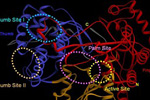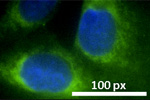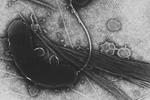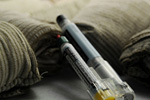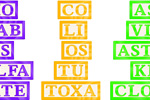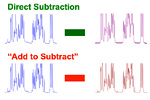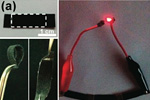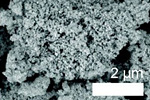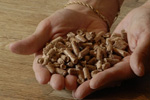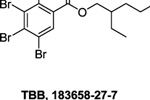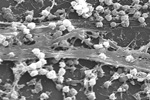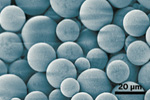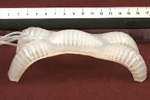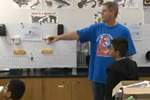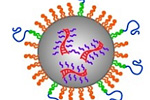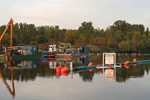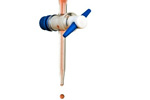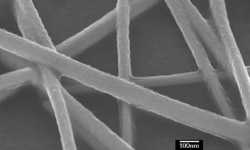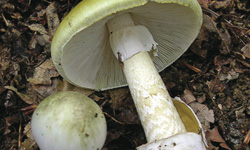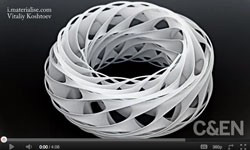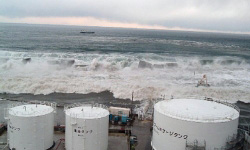
January 23, 2012
A Glucose Meter That Detects Viruses
Although scientists have developed many portable DNA detectors for doctors to use in the field to find viruses, none have hit the market. To get to the clinic in a hurry, researchers have now converted a commercially available device—a glucose meter—into one that can spot viral DNA.
• Read the full story here: cenm.ag/anl52
Hepatitis C Race Heats Up
In recent months, pharmaceutical companies Bristol-Myers Squibb and Gilead have each shelled out billions of dollars to buy small companies that are developing drugs for hepatitis C. Blogger SeeArrOh describes the similarities of the molecules at the center of these deals, including how these drugs trick viruses into letting them inside.
• Read the full story here: cenm.ag/blg67
A Chemist Goes To Hollywood
In the midst of his dissertation re- search, Caltech chemistry graduate student Evans Boney found time to act in "The PHD Movie," which is based on Jorge Cham's well-known Web comic. At the Just Another Electron Pusher blog, Christine Herman talks to Boney about his experiences in movies and television, and about his graduate adviser's reaction to his unusual career path.
• Read the full story here: cenm.ag/blg66
Quantum Dots From Carbon Fibers
Researchers have stumbled upon a cheap and simple method to produce graphene particles that shine like quantum dots. These small flakes could be a less toxic alternative to the metal-based quantum dots that researchers use to image cells.
• Read the full story here: cenm.ag/mat5
January 16, 2012
Fuel Cell Taps Into Roach Power
Because of cockroaches' hardy constitution, some scientists envision outfitting them with tiny sensors or cameras and sending them to collect data in conditions that are harmful or inaccessible to people. In a step toward creating such insect soldiers, researchers now report that a small device can generate electricity from sugar in a cockroach's blood.
• Read the full story here: cenm.ag/bio6
Making Use Of A Medical Museum's Oddities
At the Mütter Museum in Philadelphia, visitors can stroll past medical oddities: slices of Albert Einstein's brain, the cadaver of an obese woman that turned into soap, and a wall of human skulls from around the globe. But Senior Editor Sarah Everts explains that the museum's collections haven't fascinated just fans of the macabre, they've also helped medical researchers study disease.
• Read the full story here: cenm.ag/blg65
Molecules To Protect The Brain From Nerve Gas
A new family of oxime compounds can cross the blood-brain barrier in mice and protect the animals from nerve gas poisoning. The researchers who developed them hope the molecules can serve as antidotes for exposure to nerve gas or certain pesticides.
• Read the full story here: cenm.ag/bio5
Test Your Drug- Naming Knowledge
In the word esomeprazole, the generic name of the best-selling drug Nexium, the -prazole stem describes the molecule as a benzimidazole antiulcer drug. After reading about where generic drug names come from (page 36), see how fast you can match eight drug names to their definitions in an online game.
• Read the full story here: cenm.ag/generic
January 9, 2012
Cleaning Up Cluttered Spectra
When researchers use nuclear magnetic resonance spectroscopy to analyze the contents of biological samples, signals from a few compounds often swamp the rest. A new method sup- presses the unwanted signals by first boosting them. The method could help researchers discover small-molecule biomarkers for disease.
• Read the full story here: cenm.ag/anl51
CT Scans Of Hams
To create a tasty dry-cured ham or prosciutto, producers monitor the cur- ing process by slicing into the pork and testing its water and salt content. Now researchers report that by placing a ham in a CT scanner, they can keep the ham whole and still track the meat's salt level.
• Read the full story here: cenm.ag/blg64
Flexible Power Source From Soot
Electronic devices such as displays, sensors, and medical implants are well on their way to becoming flexible. But flexible power sources to operate them are just starting to catch up. Researchers now report a simple method that uses carbon nanoparticles from soot to fabricate bendable supercapacitors.
• Read the full story here: cenm.ag/mat4
Quick Snapshot Of Protein Aggregation
Researchers have developed a high-resolution technique to analyze the size of protein aggregates as they form. They hope the method, which uses electrospray ionization mass spectrometry, will help scientists study the molecular mechanisms behind diseases such as Alzheimer's and control the quality of protein-based drugs.
• Read the full story here: cenm.ag/protag
January 2, 2012
Top 10 Videos of 2011
A soft robot that slinks, conductive silver ink, and 3-D printed objects galore—you can see all these and more in C&EN's top 10 videos for 2011, chosen from the magazine's YouTube channel and Newscripts blog. C&EN Associate Editor Lauren Wolf lays out the fun, quirky picks.
• Read the full story here: cenm.ag/11vids
Method Reveals Nanoparticle Solubility
Scientists studying how nanomaterials behave in the environment have developed a technique for assessing how quickly the tiny particles dissolve in aqueous solutions. It could help scientists design environmentally benign materials.
• Read the full story here: cenm.ag/nanoag
Lithium-Ion Batteries Built To Last
Electronic gadgets and electric vehicles would run longer if lithium-ion batteries could store more energy. Such high-energy batteries would need to hold more ions, or charge, than do batteries equipped with today's standard graphite electrodes. Researchers have now made electrodes out of porous germanium that hold more than three times as much charge as their graphite counterparts do.
• Read the full story here: cenm.ag/anod
Cleaning Up Cluttered Spectra
When researchers use nuclear magnetic resonance spectroscopy to analyze the contents of biological samples, signals from a few compounds often swamp the rest. A new method sup- presses the unwanted signals by first boosting them. The method could help researchers discover small-molecule biomarkers for disease.
• Read the full story here: cenm.ag/anl51
December 19, 2011
Positive Charges Increase Protein's Appetite Boost
By adding positive charges to a protein that stimulates appetite, researchers have produced a superpotent version that greatly increases weight gain in rats. The work may help scientists develop treatments for cachexia, a bodywasting syndrome associated with diseases including cancer and AIDS.
• Read the full story here: cenm.ag/bio4
Bacterial ID In Half An Hour
A doctor can wait for days to get laboratory results identifying the microbe behind a patient's illness. But a new biosensing chip can do the same thing onsite in minutes. The chip both breaks apart cells and detects bacterial DNA.
• Read the full story here: cenm.ag/anl50
Synthetic Stones Capture Carbon
While scrubbers in smokestacks at coal plants can pull out toxic gases like sulfur dioxide, scientists haven't yet developed a cost-effective technology to remove carbon dioxide from industrial exhaust. Now European researchers have tinkered with the chemical composition of limestone to produce a material that absorbs almost twice as much CO2 as the natural mineral can.
• Read the full story here: cenm.ag/co2stones
On Birth Control And Plan B
This month, the Department of Health & Human Services blocked a Food & Drug Administration recommendation to lift age restrictions on over-the- counter access to the emergency con- traceptive pill, also called the morning after pill or Plan B. Blogger SeeArrOh describes the pharmacology of its synthetic hormone and the beauty of its steroid structure.
• Read the full story here: cenm.ag/blg56
December 12, 2011
Burning Biomass Could Save Money
Policymakers consider biomass derived fuels attractive for generating electricity because they produce lower greenhouse gas emissions than coal does. But a recent study suggests this isn't the best use of biomass. Researchers report that burning biomass, such as switchgrass pellets, instead of fuel oil to heat homes is a far cheaper way to cut emissions.
• Read the full story here: cenm.ag/bbioma
New Flame-Retardant Levels Rising Rapidly
Flame retardants called polybrominat- ed diphenyl ethers (PBDEs) volatilize from products such as upholstered furniture and electronics and escape into the environment, where they may cause problems. A study suggests newer retardants designed to replace PBDEs are now also widespread in the air.
• Read the full story here: cenm.ag/zipp
More Work To Do On Lithium-Ion Batteries
Because lithium-ion batteries can reach high, fire-starting temperatures if damaged, General Motors this month offered to buy back Chevy Volts from customers worried that the car's battery would catch fire after an accident. C&EN Senior Editor Melody Bomgard- ner discusses BMW and Toyota's joint plan to develop better batteries.
• Read the full story here: cenm.ag/batts
Science On The Chesapeake Bay
While federal regulators, farmers, and housing developers argue over a plan to clean up the Chesapeake Bay (page 10), scientists continue to monitor the health of the bay's ecosystems. On C&EN's YouTube channel, watch a series of videos of researchers describing their work, including a project to study the effects of low oxygen levels on mollusks.
• Read the full story here: cenm.ag/chesapeake
December 5, 2011
Bacteria's Kryptonite?
When bacteria form slimy biofilms, they extrude polysaccharides and other molecules to weave a matrix that helps them adhere to surfaces, evade the immune system, and communicate with each other. Researchers have now synthesized a chemical that breaks through this microbial goo. They hope the com- pound can render resistant bacteria vul- nerable to annihilation by antibiotics.
• Read the full story here: cenm.ag/bio3
Lab On A Bubble
To detect a chemical of interest in solution, analytical chemists sometimes scavenge for it by tossing in antibody-covered beads. To analyze their captured chemicals, chemists have to herd the beads using centrifugation or magnetic fields. Now researchers report a faster, simpler method to concentrate their samples that relies on silica spheres that float in a bubble (shown).
• Read the full story here: cenm.ag/anl49
Soft Robots Inch Forward
With air inflating each of its four legs, a small white robot inches along like a starfish on the ocean floor. But unlike most robots, this one's body is made of elastomeric polymers, not metal. Re- searchers think these soft robots could be a simple, cheap alternative to conventional ones. Watch C&EN's YouTube channel to see the soft robot crawl and undulate.
• Read the full story here: cenm.ag/vid12
Solar-Powered Outreach
In September, a chemistry professor packed a U-Haul truck with science demonstration equipment and drove along the 2,000-mile U.S.-Mexico border from California to Texas. By teaching elementary school children about solar energy, he hoped to excite Hispanic students about science and technology (page 40). Check out a video of his demonstrations in one Texas school.
• Read the full story here: cenm.ag/vid11
November 28, 2011
Fatty Bundles Sneak siRNA Into Cells
Inside a cell, small interfering RNAs (siRNAs) can silence genes responsible for disease, making them ideal molecules for gene therapy. But siRNAs have trouble getting there. Now researchers report that they can smuggle the nucleic acids into cells by wrapping them in lipid nanoparticles.
• Read the full story here: cenm.ag/bio2
Activated Carbon Sops Up PCBs
To clean up rivers and lakes contaminated with persistent pollutants such as polychlorinated biphenyls (PCBs), crews often must dig up the contaminated sediments and move them to another location. New research suggests a cheaper, easier alternative: Adding activated carbon to river sediments can reduce PCB concentrations in the water and in worms that live in the sediments.
• Read the full story here: cenm.ag/biphen
Shrinky Dinks Dance
Never have Shrinky Dinks seemed so elegant. Researchers turned the prestressed plastic sheets into self-folding structures using only black ink and infrared light (see page 48). Watch a video of them dancing slowly and precisely into 3-D shapes: a cube, a zigzag, and a pyramid.
• Read the full story here: cenm.ag/vid10
ACS Committees Report
The effects of federal budget cuts on research funding, the training of chemical entrepreneurs, and the planned launch of the "Ask the Ethics Committee" online resource were among the many topics discussed by ACS committees at the fall national meeting in Denver. This week, C&EN compiles official reports from the committees' presentations.
• Read the full story here: cenm.ag/acs4
November 21, 2011
Overthrowing A Titrant
Titration, a standard procedure for figuring out the amount of a chemical dissolved in a sample, usually requires the precise determination of volume. Now researchers have developed a simplified approach that uses a tracer instead of tedious measurements.
• Read the full story here: cenm.ag/anl48
Alternative Jet Fuels Cut Particulate Emissions
Because of planes' emissions, large airports are important sources of local air pollution including fine particulate matter, which can increase people's risk of heart disease and asthma. A study has found that particulate matter emissions from a plane's engine can fall by almost 40% when researchers blend jet fuel with alternative fuels.
• Read the full story here: cenm.ag/skies
Botulinum Toxins Could Soothe Inflammation
Doctors sometimes inject tiny doses of paralyzing botulinum toxins under people's skin to treat muscle spasms, relieve migraine headaches, and—perhaps most famously—smooth away wrinkles. Redirecting the toxins from nerve cells to immune cells could also combat chronic inflammation, according to a new report.
• Read the full story here: cenm.ag/wrinkle
Garden State Hosts Art Conservation
An analytical chemistry conference may be a surprising forum for discussing art, but the Eastern Analytical Symposium & Exposition hosts an annual series of talks on the science of art and cultural heritage conservation. C&EN Senior Editor Celia Arnaud shares highlights at the Artful Science blog.
• Read the full story here: cenblog.org/artful-science
November 14, 2011
Biomarkers Distinguish Microbial Friend From Foe
Health-promoting microbes that live in the gut must put up with bile, a digestive fluid that can break down bacterial membranes. Now researchers have identified a cluster of bacterial proteins linked to bile tolerance that could help scientists find new probiotic strains.
• Read the full story here: cenm.ag/bio1
Less Costly Flexible, Transparent Electrodes
During the past several years, strong de mand for liquid-crystal displays for televisions and portable electronics has driven up the price of indium, a key element used to produce the devices' transparent electrodes. A new method for making these electrodes from nanomaterials could produce a cheap alternative.
• Read the full story here: cenm.ag/mat3
Herbal Remedy For Mushroom Poisoning?
To avoid a deadly dinner, novice mushroom hunters should heed the Croatian proverb: "All mushrooms are edible, but some only once." One of the most poisonous fungi is the death cap, which produces a toxin that inhibits the primary RNA polymerase in our bodies. At Terra Sigillata, C&EN blogger David Kroll discusses a treatment for death cap poisoning that has transitioned from folk medicine to the emergency room.
• Read the full story here: cenm.ag/blg55
3-D Printer In Action
In perhaps 20 years, three-dimensional printers—machines that build objects layer by layer from powders, liquids, and pastes—could be everyday house- hold appliances, producing food, jewelry, and furniture (page 10). On C&EN's YouTube channel, you can watch a 3-D printer use piles of nylon powder to build a vehicle part, 100 μm at a time.
• Read the full story here: cenm.ag/vid9
November 7, 2011
Speedy Detection Of Homemade Explosives
A new portable device detects home- made explosives of a kind frequently used for terrorist attacks about 20 times faster than previously possible. Researchers hope the test can expand the range of explosives detected by airport screening without taking more of passengers' time.
• Read the full story here: cenm.ag/boom
Finish Fetish Chemistry
In the 1960s and '70s, a group of sculptors called the Finish Fetish mixed the aesthetics of the Los Angeles surf scene with the science of the emerging aeronautical and chemical industries. At the Artful Science blog, C&EN Senior Editor Sarah Everts describes how one such artist, De Wain Valentine, concocted a new resin to construct seamless gigantic monoliths.
• Read the full story here: cenm.ag/artfinish
Good And Bad News About Fukushima
As of July, the waters around the earthquake- and tsunami-crippled Fukushima Daiichi Nuclear Power Station in Japan had levels of radioactive material that were about 10,000 times greater than background levels, according to a new report. These levels may not pose major threats, but the accident's hu- man health and ecological implications are still unclear, the researchers say.
• Read the full story here: cenm.ag/env61
Rumors Swirling Around DuPont's Coatings Unit
DuPont may put its performance coatings business up for sale, according to recent stories citing anonymous sources. The division, which has been the company's least profitable for the past three years, produces coatings for automobiles and planes. C&EN Senior Editor Alex Tullo runs through the circulating rumors.
• Read the full story here: cenm.ag/blg53

